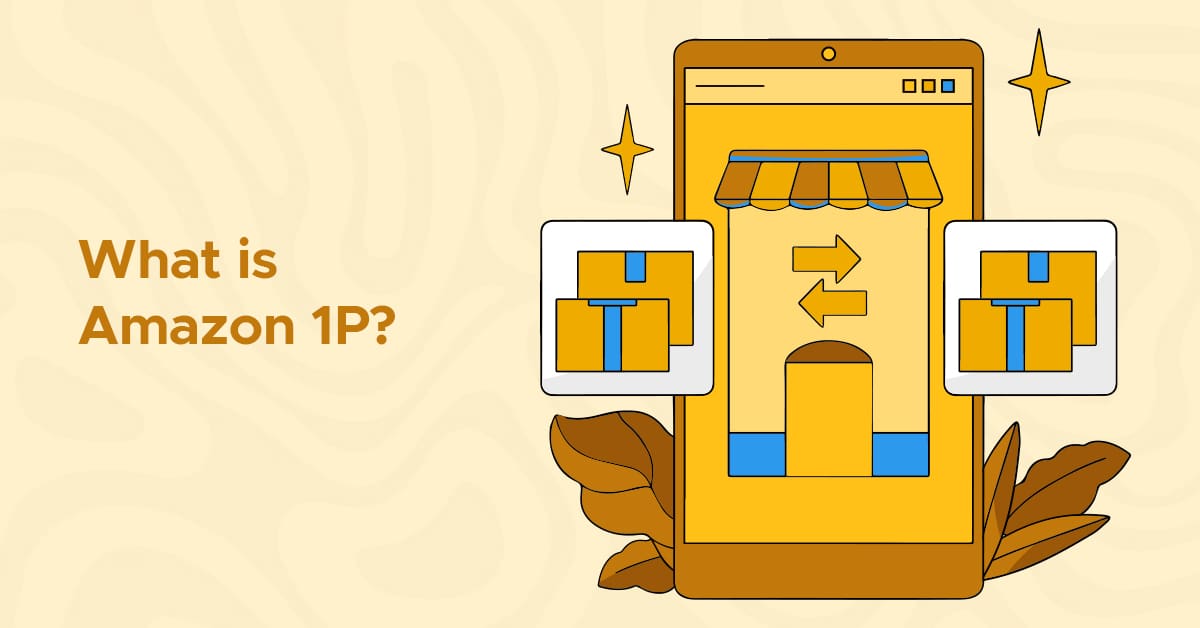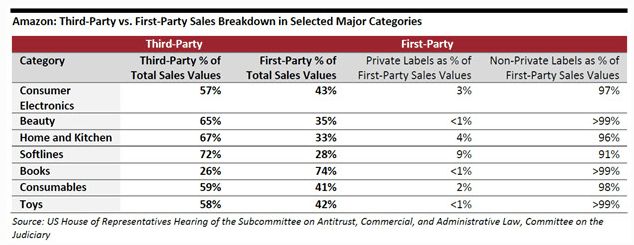
What Is Amazon 1P?

Of the estimated 2.5 million active sellers on Amazon, nearly 60% are third-party (3P) sellers. The remaining are 1P sellers who directly sell to Amazon via Vendor Central (be aware though, this program is invite-only). If you’re starting out on the marketplace, Amazon 1P selling is a promising option that can allow you to sell products through Amazon without the hassle of opening a storefront and managing your own brand. That comes with a few cons as well, but for nearly a million vendors, it’s a lucrative venture.
In this article, we’ll discuss what Amazon 1P is and what selling on Vendor Central entails. We’ll also cover how you can break into this niche and provide some tips to drive success.
What is Amazon Vendor Central?
Amazon Vendor Central is the portal where sellers can upload their products so Amazon can place bulk inventory orders. The marketplace purchases items from you directly and then lists them on their platform. Rather than pushing your own products, you tell Amazon what you have, they choose whether or not to buy it, and you hand everything to them.
That means you ship a box or pallet directly to Amazon, deal with any questions the company has about the order — and that’s it. When Amazon sells the product to end customers, they take on every other aspect of the process, including pricing, advertising, marketing, fulfillment, customer service, reverse logistics, etc.
Often, Vendor Central, or 1P, sellers are manufacturers and suppliers who produce goods in large volumes and don’t want to deal with hands-on selling. Or, it could be aggregators who may have too much to handle and want to remove some of the burden of managing sales over to Amazon while they scale up infrastructure. So, don’t rule yourself out if you don’t perfectly fit the “manufacturer” category.
Further, while Amazon’s 3P sellers make up an estimated 62% of all sales, 1P sellers still own a significant portion of Amazon sales revenue.

The model features terms that allow you to step in and continue to spend money on Amazon. For example, Amazon takes on costs of fulfillment and more, but you can still run advertising for products yourself with the platform’s self-serve sponsored ads and cooperations with Amazon. You’ll have little to no control over inventory though.
Amazon 1P fees
Amazon 1P sellers also pay fees, although in a different structure than 3P. For example, you’re paid for products through a bulk invoice in advance of sales. Amazon issues you a purchase order, you ship products, and they pay the invoice in 60 days. They can also choose to pay in 30 days for a 2% discount, which is deducted from your payment.
You’ll also pay fees for:
- Marketing, remittance, prepayment, and packaging: 4%–10%, depending on your contract with Amazon
- Marketing Development Fund (MDF): 13%–22%
- Freight Allowance: 2%–5%
- Damage Allowance: 2%–11%
- Chargebacks: You receive chargebacks for mislabeling, improper packing, late arrival, accepting purchase orders too late, and the like. For this reason, most 1P vendors invest in an Amazon prep service.
Fee amounts vary because Amazon 1P sellers negotiate this up front and have custom terms in their Vendor Central contract.
Examples of Amazon 1P sellers
To give you a better understanding of 1P selling in the real world, we’ve listed a few well-known names:
- Corsair: Corsair Gaming, Inc. is a computer peripherals and gaming brand based in California. The brand sells across multiple retail stores, including big box retailers like Best Buy. They also sell 1P to Amazon through a storefront where the marketplace directly retails Corsair products to their customers. While entirely 1P, Corsair is a prominent computer peripherals storefronts on the Amazon marketplace.
- MSI: MSI is one of the world’s largest computer brands, with a selection of business, gaming, and work laptops. The company primarily distributes directly to Amazon via a 1P contract. However, they also have other distributors, so you can find multiple sellers distributing the same products across Amazon.
- Corelle: Corelle is the largest brand of dinnerware and dishware in the U.S. They sell directly to Amazon as a 1P vendor as well and offer some of the best-selling products in their category, with many of their listings featuring over 16,000 reviews.
Each of these 1P sellers shares the same commonalities: Amazon buys products directly, ships them to a warehouse, builds a storefront, and then fully controls every aspect of pricing, fulfillment, customer service, and sales. These sellers can influence sales with their own marketing and advertising, but mostly, it’s in Amazon’s hands.
How to become an Amazon 1P seller
If you want to sell 1P, you need an invite. Amazon invites sellers based on the following criteria:
- You manufacture or sell unique/owned products.
- You typically have a sales volume of over $10 million.
- You have minimal or no presence on Amazon.
Essentially, you need an established brand and a high sales volume with other distributors to be eligible.
Once you receive the invitation, setting up your account is a simple matter of signing in to Vendor Central, uploading products, and adding listings:
- Fill out your profile: This includes tax information, payment information, aligning shipment dates, etc.
- Upload products: This is found under Images. You can bulk upload these with an Excel import. Make sure you have photos and product descriptions ready to go (although Amazon may opt to update these to their own).
- Set pricing: You’ll set wholesale pricing in the platform. This is normally done by lot, case, or batch of products — never by individual product. Amazon may email you to let you know your price point is too high, but if they can’t profit from the product, they won’t buy it.
From there, you wait for Amazon to send a purchase order, after which you’ll have 24 hours to confirm it and choose a listed time to fulfill the order. That entails prepping the products, labeling them, packaging them according to Amazon guidelines, and shipping them to the designated warehouses.
The advantages of selling 1P
There are plenty of reasons you might want to sell 1P:
- You enjoy a simplified revenue model — one point of sale and one point of customer service, and you don’t have to deal with individual buyers, fulfillment, etc.
- You leverage Amazon’s logistics and infrastructure for all sales.
- You rely on Amazon’s merchandising, listing optimization, etc.
- Products are listed as “sold by Amazon” on the platform, which can increase buyer trust and therefore increase sales.
- 1P vendors gain access to increased advertising opportunities.
- You reduce administration; with fewer fees and pitfalls and less to manage, it’s easier to keep track of revenue.
Mostly, 1P selling is a classic wholesale selling model, ideal for brands that want to sell products in a high volume, without taking on the hassle of direct to consumer.
The disadvantages of selling 1P
There are also many reasons 1P sellers might prefer to sell 3P, including:
- You sell wholesale, which limits profitability.
- Once Amazon purchases your product, they control pricing, merchandising, and inventory.
- Amazon chooses whether or not they sell your product so, if they stop placing orders, you lose a revenue stream.
- You still have to prep products to meet Amazon’s requirements.
- Getting into Vendor Central is difficult. Without Amazon’s Vendor Central Express, it’s hard to receive an invite to the platform.
In general, Amazon 1P isn’t ideal for brands that aren’t suited to wholesale selling.
Is selling wholesale to Amazon right for your brand?
Selling 3P offers more control over inventory, pricing, and sales. However, not every seller wants to take on the workload of building infrastructure or hiring additional help to tackle individual order fulfillment, customer service, and merchandising. For many brands, the solution is to sell 3P with the assistance of a third-party logistics provider, but you may find you also need extra support for customer service and inventory management.
Tips for selling 1P
When selling 1P, you have to adhere to Amazon’s strict prep requirements, carry out POs, and invest in the platform. Other critical recommendations include:
- Organize product prep and inbound shipments and manage those costs. A prep service ensures labeling and packaging is perfect so you won’t have to worry about chargebacks.
- Invest in quality merchandising up front, which gives you more control over how your brand is presented across Amazon.
- Push brand marketing with Vine and Brand Registry.
- Work out an advertising budget based on profit margin and spend on ads, as this will increase sales and, therefore, the volume of Amazon POs.
- Stay on top of fees and track your profit margins since Amazon’s fees are deducted from your wholesale costs.
Selling 1P can greatly reduce your costs because you need less infrastructure and less administration. However, it’s still important to stay on top of what you’re actually paying so you have oversight of the full process.
Wrapping up — Consider the Amazon 1P selling model for your business
The Amazon 1P selling model is a great option for entrepreneurs interested in selling wholesale to Amazon. The marketplace is your sole customer, and you gain access to their infrastructure, advertising outlets, and reduced fees. However, you still have to prep all shipments to Amazon, as well as give up significant control to the platform. If you run the numbers and decide selling 1P is right for you, use this article as your guide to embrace this venture and maximize your profit margins.


